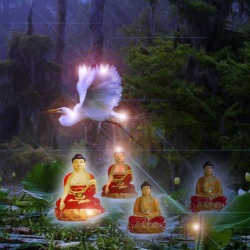Difference between revisions of "A Discourse on Paticcasamuppada or The Doctrine of Dependent Origination"
(Created page with " <poem> A Discourse on Paticcasamuppada or The Doctrine of Dependent Origination / Chapter 5 - Manodvara Vithi Chapter 5 - Manodvara Vithi...") |
|||
| Line 1: | Line 1: | ||
| − | + | [[File:602tyutyu.jpg|thumb|250px|]] | |
<poem> | <poem> | ||
A [[Discourse on Paticcasamuppada]] or The [[Doctrine of Dependent Origination]] | A [[Discourse on Paticcasamuppada]] or The [[Doctrine of Dependent Origination]] | ||
| − | |||
| − | |||
[[Chapter]] 5 - [[Manodvara]] [[Vithi]] | [[Chapter]] 5 - [[Manodvara]] [[Vithi]] | ||
| Line 9: | Line 7: | ||
The [[mind]] [[vithi]] is of three kinds according to the [[javana]] involved, viz., [[kammajavana]], [[jhanajavana]] and [[maggaphalajavana]]. Here, what matters is [[vithi]] with [[kammajavana]]. While the [[bhavanga]] {{Wiki|stream}} is flowing, there appear [[mental images]] of the [[sense objects]] that one has [[experienced]] or, sometimes, those which one has not [[experienced]]. Then [[bhavanga]] is disturbed and next [[time]] it is cut off. This is followed by {{Wiki|reflection}} which is somewhat like [[vuttho]] ([[decision]]) in the [[five sense organs]]. Like [[vuttho]], {{Wiki|reflection}} ([[avajjana]]) leads to [[javana]], giving rise to agreeable or [[disagreeable]] [[emotions]] such as {{Wiki|fear}}, [[anger]], [[confusion]], [[devotion]], awe, [[pity]] and so forth. The {{Wiki|impulses}} [[arising]] at the [[five sense organs]] are weak and they neither lead to good or bad [[rebirth]] nor produce much other effects. But the {{Wiki|impulses}} in the [[mind]] are potent enough to determine the quality of [[rebirth]] and all other [[kammic]] results. So it is necessary to guard and control these {{Wiki|impulses}}. After seven impulse moments followed by two [[tadarammana]] moments the [[mind]] sinks into [[bhavanga]] state. | The [[mind]] [[vithi]] is of three kinds according to the [[javana]] involved, viz., [[kammajavana]], [[jhanajavana]] and [[maggaphalajavana]]. Here, what matters is [[vithi]] with [[kammajavana]]. While the [[bhavanga]] {{Wiki|stream}} is flowing, there appear [[mental images]] of the [[sense objects]] that one has [[experienced]] or, sometimes, those which one has not [[experienced]]. Then [[bhavanga]] is disturbed and next [[time]] it is cut off. This is followed by {{Wiki|reflection}} which is somewhat like [[vuttho]] ([[decision]]) in the [[five sense organs]]. Like [[vuttho]], {{Wiki|reflection}} ([[avajjana]]) leads to [[javana]], giving rise to agreeable or [[disagreeable]] [[emotions]] such as {{Wiki|fear}}, [[anger]], [[confusion]], [[devotion]], awe, [[pity]] and so forth. The {{Wiki|impulses}} [[arising]] at the [[five sense organs]] are weak and they neither lead to good or bad [[rebirth]] nor produce much other effects. But the {{Wiki|impulses}} in the [[mind]] are potent enough to determine the quality of [[rebirth]] and all other [[kammic]] results. So it is necessary to guard and control these {{Wiki|impulses}}. After seven impulse moments followed by two [[tadarammana]] moments the [[mind]] sinks into [[bhavanga]] state. | ||
| − | Thus, the [[vithi]] process at [[manodvara]] involves one [[avajjana]] moment, seven [[javana]] moments and two [[tadarammana]] moments. In the case of dim and indistinct [[objects]], the [[mind]] skips [[tadarammana]], passes through [[javana]] and reverts to [[bhavanga]]. If the [[object]] is very weak, the [[mind]] does not attain even [[javana]] but has two or three [[avajjana]] moments. This is natural if we bear in [[mind]] the way we have to focus on [[mind]] [[objects]] in [[vipassana]] practice. The only resultant [[citta]] in this [[mano | + | Thus, the [[vithi]] process at [[manodvara]] involves one [[avajjana]] moment, seven [[javana]] moments and two [[tadarammana]] moments. In the case of dim and indistinct [[objects]], the [[mind]] skips [[tadarammana]], passes through [[javana]] and reverts to [[bhavanga]]. If the [[object]] is very weak, the [[mind]] does not attain even [[javana]] but has two or three [[avajjana]] moments. This is natural if we bear in [[mind]] the way we have to focus on [[mind]] [[objects]] in [[vipassana]] practice. The only resultant [[citta]] in this [[mano vithi]] is [[tadarammana]], the other two being [[kiriya citta]], the [[citta]] that does not stem from [[sankhara]]. |
</poem> | </poem> | ||
{{R}} | {{R}} | ||
[http://www.wisdomlib.org/buddhism/book/a-discourse-on-paticcasamuppada/d/doc1936.html www.wisdomlib.org] | [http://www.wisdomlib.org/buddhism/book/a-discourse-on-paticcasamuppada/d/doc1936.html www.wisdomlib.org] | ||
[[Category:]] | [[Category:]] | ||
Revision as of 16:38, 1 September 2014
A Discourse on Paticcasamuppada or The Doctrine of Dependent Origination
Chapter 5 - Manodvara Vithi
The mind vithi is of three kinds according to the javana involved, viz., kammajavana, jhanajavana and maggaphalajavana. Here, what matters is vithi with kammajavana. While the bhavanga stream is flowing, there appear mental images of the sense objects that one has experienced or, sometimes, those which one has not experienced. Then bhavanga is disturbed and next time it is cut off. This is followed by reflection which is somewhat like vuttho (decision) in the five sense organs. Like vuttho, reflection (avajjana) leads to javana, giving rise to agreeable or disagreeable emotions such as fear, anger, confusion, devotion, awe, pity and so forth. The impulses arising at the five sense organs are weak and they neither lead to good or bad rebirth nor produce much other effects. But the impulses in the mind are potent enough to determine the quality of rebirth and all other kammic results. So it is necessary to guard and control these impulses. After seven impulse moments followed by two tadarammana moments the mind sinks into bhavanga state.
Thus, the vithi process at manodvara involves one avajjana moment, seven javana moments and two tadarammana moments. In the case of dim and indistinct objects, the mind skips tadarammana, passes through javana and reverts to bhavanga. If the object is very weak, the mind does not attain even javana but has two or three avajjana moments. This is natural if we bear in mind the way we have to focus on mind objects in vipassana practice. The only resultant citta in this mano vithi is tadarammana, the other two being kiriya citta, the citta that does not stem from sankhara.
Source
www.wisdomlib.org [[Category:]]
